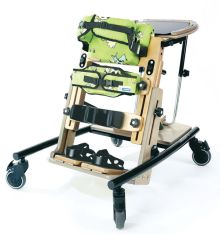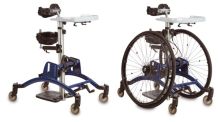Understanding the Difference: Prone vs. Supine Standers
Lying in the prone position is another way to say the person is lying face down on their stomach. The support surface of a prone stander is in front of the person using the stander. The angle of the stander is adjustable from upright forward towards the horizontal (leaning forward). Prone standers help the user strengthen the extensor muscles located on the back of the body as this stander requires activation of the muscles that lift the head and upper back. The person using the stander should have good neck strength and at least fair trunk strength. Usually this type of stander is used with a tray. These standers can encourage weight bearing through the arms and they can assist with active use of the arms as arms tend to naturally fall forward into gravity towards midline and into the line of vision encouraging awareness and functional use. Users should also have a symmetrical spine and full hip extension to use a prone stander.
Why Stand?The list of benefits derived from standing is long and impressive. Standing provides many physiological benefits including increasing bone density, aiding the digestive process and improving circulation. But there are also social and emotional benefits that go along with the upright standing position. These benefits are significant to a person’s well-being whether independent standing and walking is a realistic goal or not.
Choosing the Right Prone Stander to Meet Your Needs
You will find a huge selection of prone standers to choose from here at Adaptivemall .com. Most have a large selection of accessories to meet unique postural support needs. With so many products available, it can be difficult to decide which one is best. A good place to start is checking in with your therapist. For additional information or to get personalized sizing advice, please send us a size help request. This service is free and important to getting the perfect fit! This equipment is appropriate for but not limited to use with persons with diagnosis of Cerebral Palsy, Spina Bifida, Muscular Dystrophy and Traumatic Brain Injury.













